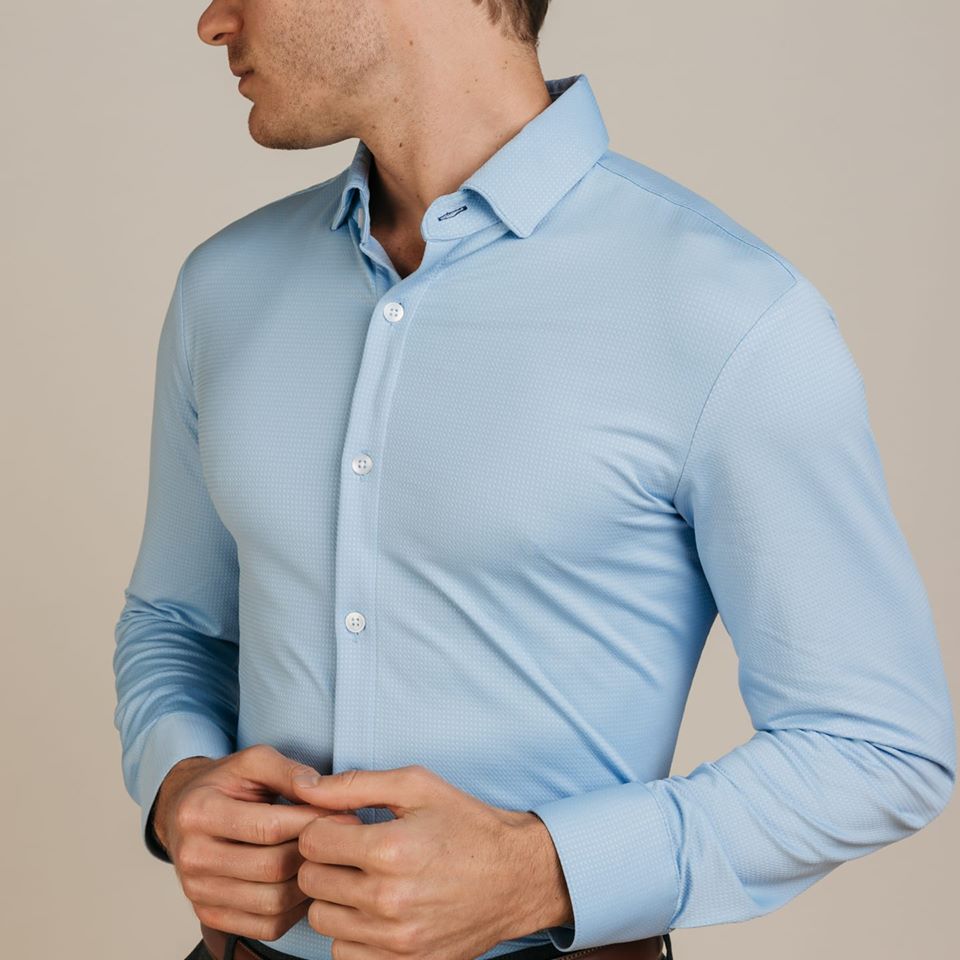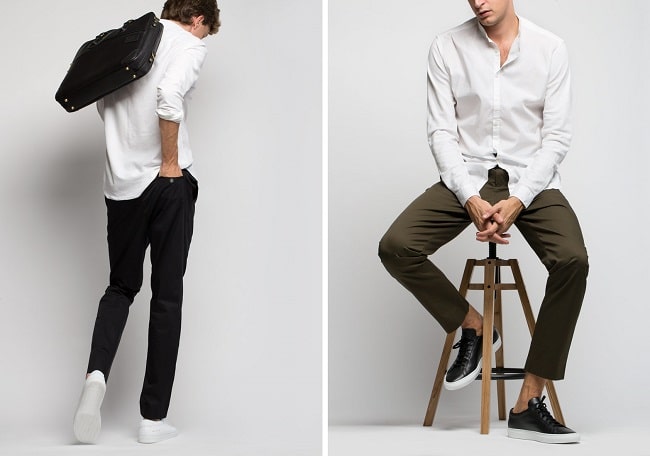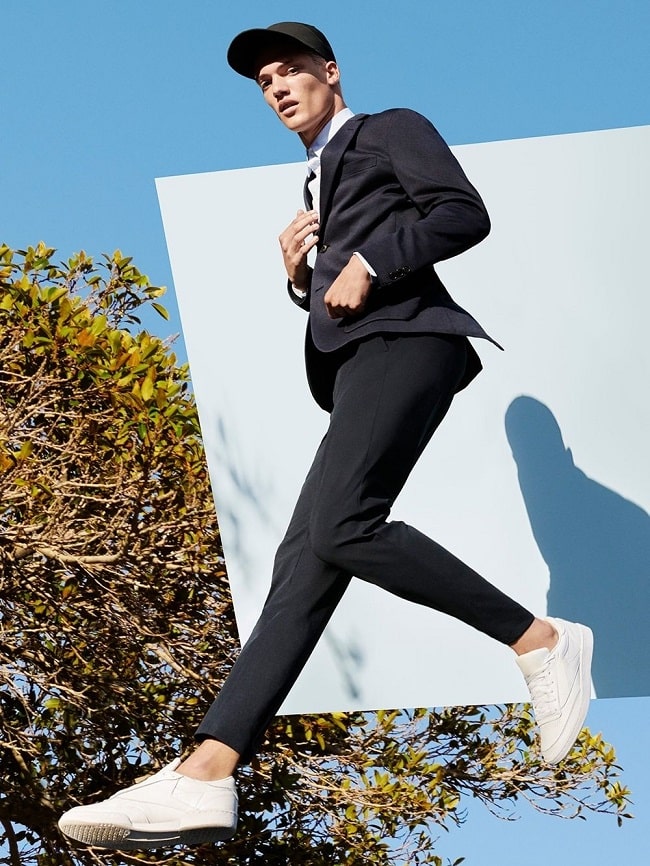1
HOME > Tips & Advice >
HOW TO WEAR STRETCH-BASED DRESS FABRICS
ENHANCING TRADITIONAL SILHOUETTES WITH JUST A HINT MORE COMFORT
Written by Ivan Yaskey in Tips & Advice on the 30th October 2018

They’re in your trousers and jeans, and they’ve made your button-up shirts feel more comfortable. Stretch materials – more specifically, the addition of polyester or spandex – take the scratchiness and stiffness out of ordinary cotton blends, and in turn, make them more bearable for the work day. If you’re of a certain age, you’ve got memories of older dress clothes: Heavy khaki trousers, shirts that once you added your tie, chafed around the collar and cuffs, and suits that barely let you move. As a kid, they were reserved for church services or ultra-special occasions, but once you entered adulthood, that dreaded fit framed your work wardrobe.
Yet, in more recent years, the performance features we’ve associated with athletic wear have crossed over into dressier, more office-appropriate clothing. Quartz covered Mizzen + Main and Ministry, the former infusing its pieces with moisture-wicking, stretchy polyester and the latter the same temperature-regulating phase-change material NASA developed for astronauts. But even at lower-end department stores, Van Heusen and Izod have gotten on board, and there’s a strong chance that button-down or a pair of khakis feels less constricting, doesn’t wrinkle as much, and is far less likely to show sweat stains after an aggravating morning on the subway.

Even Levi’s – long the accessible brand for as-close-as-you-can-get authentic denim – started adding a small amount of elastane to its classic styles. While they’re still a far cry from spray-on jeans, that one-percent addition helps the material stretch as much as four to seven percent in all directions without drastically compromising the material’s fit and feel. Yet, while stretch-blend dress fabrics have several advantages, they have a few downsides: That Lululemon look, feeling too thin and elastic-y, and accenting your body in all the wrong places. So, as you shop around for work clothes, be sure to think about the following points.
A Cotton-Like Look
Just as with the Levi’s example above, a hint of polyester or spandex shouldn’t change how the material looks. As perhaps the biggest point with stretch-blend fabrics, you don’t want to draw attention to them. Yes, you’ll feel more comfortable – and that’s the whole point – but the fabric itself should retain that woven quality. The L'Estrange London 24-Hour Trouser does this well: You see the weave, the stretchiness is barely discernible, but the softer fit with just a bit more give means you usually want a few pairs in your wardrobe. Too much polyester, on the other hand, adds that finer, almost shinier quality you see with workout clothing. Although you’ll find this, albeit intentionally, with clubbing shirts, it’s less appropriate for the office and often has a degree of cheapness to it. In short, flimsiness is fine when you’re looking to party, but in many workplaces, it comes off as a lack of seriousness.

A Good Fit
Stretch fabrics are rarely forgiving. The skin-tight material accents everything – every muscle, every bulge, and everything you want to conceal. That’s why ultra-skinny jeans better suit slimmer body shapes, and guys with more muscle should opt for a more traditional, straight cut. T.M.Lewin however, have super-fitted stretch shirts with Lycra designed to complement the powerful male physique. But these rules don’t solely apply to jeans. In fact, in shopping for your wardrobe, be ultra-attuned to how the material hugs your skin or falls about your frame. Something that’s too tight inevitably shows more than you’d like to, looks almost like you’re wearing leggings and is generally unflattering. To sum it up, it’s a fit better suited for a rock star than a top employee presenting to a client. With shirts, it’s the same thing: Keep it tailored, rather than have the buttons straining to stay in their holes across your midsection. As a tip, stick with the fits you’re used to: Now’s not the time to experiment with something tighter or slimmer. As well, if the trousers fit around the legs but usually pinch around the hips, look for an adjustable waist. Uniqlo’s Ezy Ankle-Length trousers, for instance, opt for a drawstring closure hidden behind a button and fly, creating a smoother fit in the process.

Stick with Tradition
If you could capture stretch materials with one phrase, it would be this: Enhancing traditional silhouettes with just a hint more comfort. The result is a dress shirt that doesn’t dig into your pits, khakis with some flexibility or jeans and chinos that break-in quicker. In short, while product copy promises everything from wrinkle resistance to less ironing, these won’t be like the pair of joggers or track bottoms you wear at the gym. So as to not call attention to the fabric, take a typical approach with your shirt’s or trousers’ shape. For the former, have a bit of room and preferably, a collared shirttail silhouette you can easily tuck in. With your trousers, don’t make the fit any skinnier than slim. Anything labelled 'straight' or 'regular' is preferred, as is a flat-front or moderately pleated shape.


Trending
2
3
4
5
6
7
8
9
10










